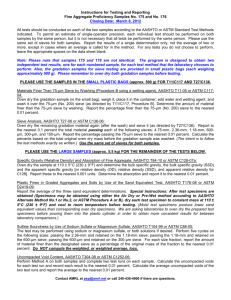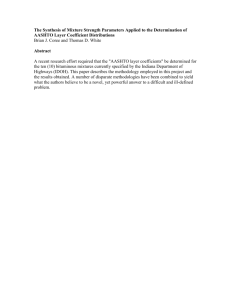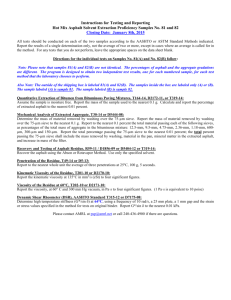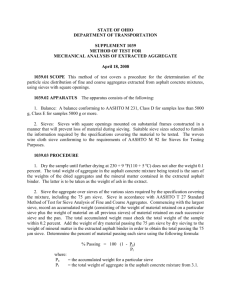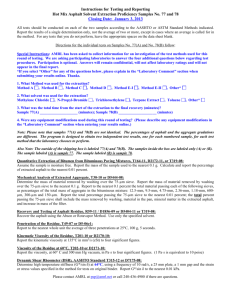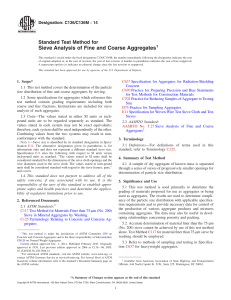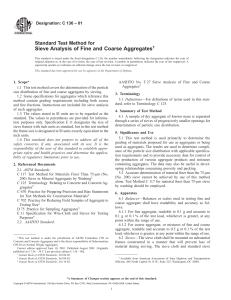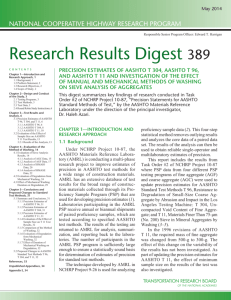Coarse Aggregate Testing Instructions: Samples 173 & 174
advertisement
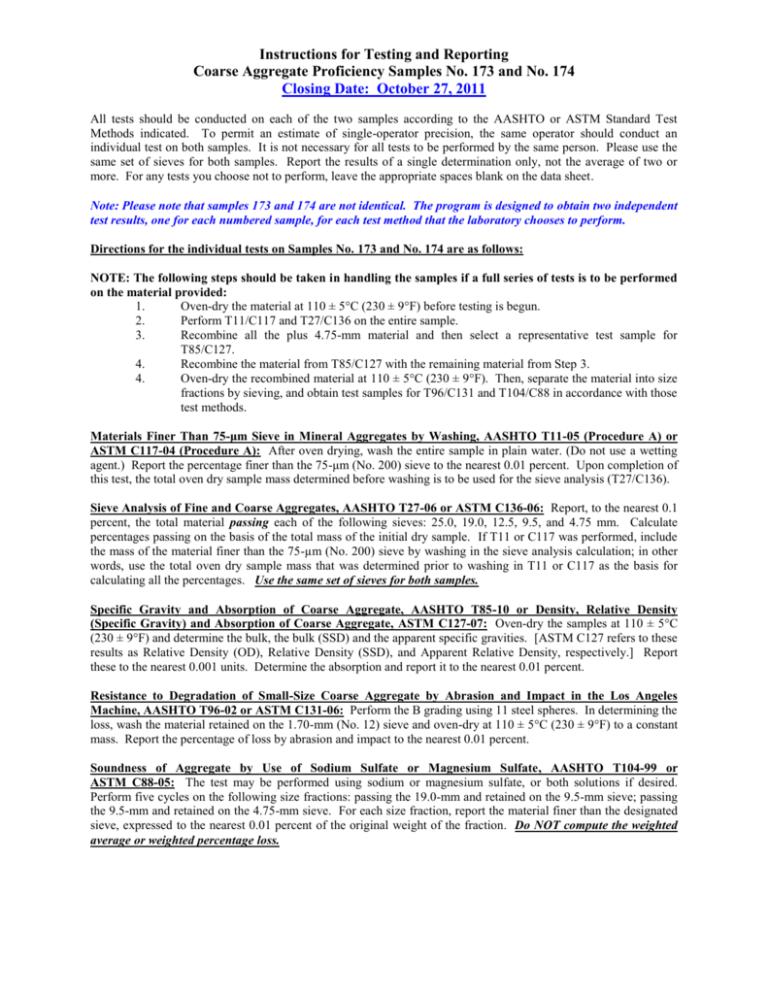
Instructions for Testing and Reporting Coarse Aggregate Proficiency Samples No. 173 and No. 174 Closing Date: October 27, 2011 All tests should be conducted on each of the two samples according to the AASHTO or ASTM Standard Test Methods indicated. To permit an estimate of single-operator precision, the same operator should conduct an individual test on both samples. It is not necessary for all tests to be performed by the same person. Please use the same set of sieves for both samples. Report the results of a single determination only, not the average of two or more. For any tests you choose not to perform, leave the appropriate spaces blank on the data sheet. Note: Please note that samples 173 and 174 are not identical. The program is designed to obtain two independent test results, one for each numbered sample, for each test method that the laboratory chooses to perform. Directions for the individual tests on Samples No. 173 and No. 174 are as follows: NOTE: The following steps should be taken in handling the samples if a full series of tests is to be performed on the material provided: 1. Oven-dry the material at 110 ± 5°C (230 ± 9°F) before testing is begun. 2. Perform T11/C117 and T27/C136 on the entire sample. 3. Recombine all the plus 4.75-mm material and then select a representative test sample for T85/C127. 4. Recombine the material from T85/C127 with the remaining material from Step 3. 4. Oven-dry the recombined material at 110 ± 5°C (230 ± 9°F). Then, separate the material into size fractions by sieving, and obtain test samples for T96/C131 and T104/C88 in accordance with those test methods. Materials Finer Than 75-μm Sieve in Mineral Aggregates by Washing, AASHTO T11-05 (Procedure A) or ASTM C117-04 (Procedure A): After oven drying, wash the entire sample in plain water. (Do not use a wetting agent.) Report the percentage finer than the 75-μm (No. 200) sieve to the nearest 0.01 percent. Upon completion of this test, the total oven dry sample mass determined before washing is to be used for the sieve analysis (T27/C136). Sieve Analysis of Fine and Coarse Aggregates, AASHTO T27-06 or ASTM C136-06: Report, to the nearest 0.1 percent, the total material passing each of the following sieves: 25.0, 19.0, 12.5, 9.5, and 4.75 mm. Calculate percentages passing on the basis of the total mass of the initial dry sample. If T11 or C117 was performed, include the mass of the material finer than the 75-µm (No. 200) sieve by washing in the sieve analysis calculation; in other words, use the total oven dry sample mass that was determined prior to washing in T11 or C117 as the basis for calculating all the percentages. Use the same set of sieves for both samples. Specific Gravity and Absorption of Coarse Aggregate, AASHTO T85-10 or Density, Relative Density (Specific Gravity) and Absorption of Coarse Aggregate, ASTM C127-07: Oven-dry the samples at 110 ± 5°C (230 ± 9°F) and determine the bulk, the bulk (SSD) and the apparent specific gravities. [ASTM C127 refers to these results as Relative Density (OD), Relative Density (SSD), and Apparent Relative Density, respectively.] Report these to the nearest 0.001 units. Determine the absorption and report it to the nearest 0.01 percent. Resistance to Degradation of Small-Size Coarse Aggregate by Abrasion and Impact in the Los Angeles Machine, AASHTO T96-02 or ASTM C131-06: Perform the B grading using 11 steel spheres. In determining the loss, wash the material retained on the 1.70-mm (No. 12) sieve and oven-dry at 110 ± 5°C (230 ± 9°F) to a constant mass. Report the percentage of loss by abrasion and impact to the nearest 0.01 percent. Soundness of Aggregate by Use of Sodium Sulfate or Magnesium Sulfate, AASHTO T104-99 or ASTM C88-05: The test may be performed using sodium or magnesium sulfate, or both solutions if desired. Perform five cycles on the following size fractions: passing the 19.0-mm and retained on the 9.5-mm sieve; passing the 9.5-mm and retained on the 4.75-mm sieve. For each size fraction, report the material finer than the designated sieve, expressed to the nearest 0.01 percent of the original weight of the fraction. Do NOT compute the weighted average or weighted percentage loss.
